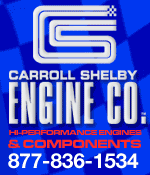 
 Main Menu
Main Menu
|
 Nevada Classics
Nevada Classics
|
 Advertise at CC
Advertise at CC
|
 November 2025
November 2025
|
| S |
M |
T |
W |
T |
F |
S |
| |
|
|
|
|
|
1 |
| 2 |
3 |
4 |
5 |
6 |
7 |
8 |
| 9 |
10 |
11 |
12 |
13 |
14 |
15 |
| 16 |
17 |
18 |
19 |
20 |
21 |
22 |
| 23 |
24 |
25 |
26 |
27 |
28 |
29 |
| 30 |
|
|
|
|
|
|
|
 CC Advertisers
CC Advertisers
|
|

07-19-2010, 07:27 PM
|
|
CC Member

|
|
|
Join Date: Oct 2003
Posts: 4,078
|
|

 Not Ranked
Not Ranked
Quote:
Originally Posted by undy

Sad to say, not sure on the pushrod oiling, it's a hydraulic roller, Ersons and Smith Bros pushrods..
|
FYI, Ersons oil in the conventional way, not through the p'rods. Any thought about my water- to- rocker- oil feed theory?
__________________
Chas.
|

07-20-2010, 04:47 AM
|
 |
CC Member

|
|
|
Join Date: Jul 2005
Location: Virginia Beach, Va & Port Charlotte, Fl.,
Posts: 2,292
|
|

 Not Ranked
Not Ranked

Quote:
Originally Posted by ERA Chas

FYI, Ersons oil in the conventional way, not through the p'rods. Any thought about my water- to- rocker- oil feed theory? |
I'll pressurize the right and left banks of the engine separately. I'll probably use some R-410A for a reference additive and back it with nitrogen. I'll run my electronic leak detector around. It's sensitive enough to pick up 1/2 an ounce of refrigerant leakage a year. If there's a leak in the rocker oil feed circuit it will pick it up.
Quote:
Originally Posted by olddog

I like Rick L proposal of putting the intake in a tank of water. Drop the pressure back to 25 psi so your block off plate gaskets do not leak. Then watch for a bubble. Stare at it a good while.
You were keeping a constant pressure from the bottle and I think I read you were using some type of sniffer. Maybe I'm confusing the Freon thing, but I didn't understand your method of looking for the leak. I would think blocking the gas in and watching for the pressure to drop off would be more of a standard test. I guess I'm not certain that your test was absolutely conclusive. Maybe it was and I just lack the understanding.
|
The entire portion of the manifold that could leak water into the oil is fully visible. I use a purpose manufactured high viscosity soap suds solution with excellent designed cling characteristics to coat all the potential leaking surface areas. It's just as good as submersion and a heck of a lot less messy. watching a bleed-down test really is not as good as a visual inspection of said areas. The bleed-down method is great when all the areas aren't visible, like an assembled engine's entire cooling system. Initially I'll probably use the bleed-down method when I pressurize the halves of the engine. If it shows results I'll start looking for specifics.
Quote:
Originally Posted by Excaliber

I to have worked in HVAC for many years, chillers to window units, even did a morgue for body storage once.  A freeze drier application was interesting, that was some very exotic and expensive gas for that unit! I never worked with ammonia, now THAT stuff is dangerous.
Freon, nitrogen, other gases, just part of the hazard. I am reminded of a news story about a fellow that filled his air mattress with Freon, he never woke up... |
Hey Ernie, always great to find a fellow "Freon Sniffer". The HVAC hustle has been good to me in life, allowing for some of the finer (and not so finer) things. I've work some ammonia too, as you said it some nasty stuff.
Actually, my oncologist sort of hinted that my CLL (Chronic Lymphotic Leukemia) is frequently caused by handling and inhaling potentially carcinogenic chemicals and gases.. Go figure.
__________________
Too many toys?? never!
|

07-20-2010, 04:22 PM
|
|
CC Member

|
|
|
Join Date: May 2006
Location: St. Louisville,
Oh
Cobra Make, Engine: A&C 67 427 cobra SB
Posts: 2,445
|
|

 Not Ranked
Not Ranked

Quote:
Originally Posted by undy

The entire portion of the manifold that could leak water into the oil is fully visible. I use a purpose manufactured high viscosity soap suds solution with excellent designed cling characteristics to coat all the potential leaking surface areas. It's just as good as submersion and a heck of a lot less messy. watching a bleed-down test really is not as good as a visual inspection of said areas. The bleed-down method is great when all the areas aren't visible, like an assembled engine's entire cooling system. Initially I'll probably use the bleed-down method when I pressurize the halves of the engine. If it shows results I'll start looking for specifics. |
I must have got confused somewhere earlier. Yes soap is a great test. Obviously you know all about leak tests in your line of work. You don't need me to tell you that.
OK it sounds like the intake is totally ruled out, and the intake gaskets maybe not totally but very low probability. I agree the next step is pressure test the block and heads together and go from there.
One question on picture #1. The block deck seems to not be solid where the intake and heads mate up. Is that a drain path to the pan or what?

|

07-20-2010, 05:31 PM
|
|
CC Member

|
|
|
Join Date: Oct 2003
Posts: 4,078
|
|

 Not Ranked
Not Ranked
Quote:
Originally Posted by olddog

I
One question on picture #1. The block deck seems to not be solid where the intake and heads mate up. Is that a drain path to the pan or what?
|
That's the head gaskets.
__________________
Chas.
|

07-20-2010, 06:41 PM
|
 |
CC Member

|
|
|
Join Date: Jul 2005
Location: Virginia Beach, Va & Port Charlotte, Fl.,
Posts: 2,292
|
|

 Not Ranked
Not Ranked

Quote:
Originally Posted by olddog

I must have got confused somewhere earlier. Yes soap is a great test. Obviously you know all about leak tests in your line of work. You don't need me to tell you that.
OK it sounds like the intake is totally ruled out, and the intake gaskets maybe not totally but very low probability. I agree the next step is pressure test the block and heads together and go from there.
One question on picture #1. The block deck seems to not be solid where the intake and heads mate up. Is that a drain path to the pan or what?
|
I just "re-clearanced" the pushrod holes in the intake where I couild see witness marks from a little pushrod contact and resculpted the water ports too to maximize coolat flow a little better. I paid my local shipper to box it up and off it went for a dose of Vacuum Casting Impregnation. I'm famous for my "overkill". The concept has worked for me thus far.
BTW... today, upon a close visual inspection of the two rear machined flat surfaces of the intake, the surfaces that block off the rear 2 coolant ports of the heads, I could of sworn I saw a bit of porosity on one adjacent to a pushrod hole. hmmm..... I didn't pressure test that end. The impregation will take care of it, assuming it is the leak. The block/heads pressure testing will hopefully show me everything else is tighter than Dick's hatband.
You guys all rock!!!
Since I didn't have a POS harmonic balancer, a screwed up clutch or an engine vibration, a lousy coolant leak is the best I could come up with.   . My time for those maladies is coming. Man ya got to love these engines. Where's McDoo's words of encouragement when ya need 'em? 
Most of my FE woes HAVE been cooling system related though...
__________________
Too many toys?? never!
|

07-20-2010, 07:47 PM
|
|
CC Member

|
|
|
Join Date: May 2006
Location: St. Louisville,
Oh
Cobra Make, Engine: A&C 67 427 cobra SB
Posts: 2,445
|
|

 Not Ranked
Not Ranked
Quote:
Originally Posted by undy

BTW... today, upon a close visual inspection of the two rear machined flat surfaces of the intake, the surfaces that block off the rear 2 coolant ports of the heads, I could of sworn I saw a bit of porosity on one adjacent to a pushrod hole. hmmm..... I didn't pressure test that end. The impregation will take care of it, assuming it is the leak. The block/heads pressure testing will hopefully show me everything else is tighter than Dick's hatband.
|
Wish you could have proven that was your leak. It may well be. If the rest of the engine holds pressure, I would bet that was it. If not, you still have to keep looking. |
 Posting Rules
Posting Rules
|
You may not post new threads
You may not post replies
You may not post attachments
You may not edit your posts
HTML code is Off
|
|
|
All times are GMT -7. The time now is 03:35 PM.
|



















 A freeze drier application was interesting, that was some very exotic and expensive gas for that unit! I never worked with ammonia, now THAT stuff is dangerous.
A freeze drier application was interesting, that was some very exotic and expensive gas for that unit! I never worked with ammonia, now THAT stuff is dangerous.
 . My time for those maladies is coming. Man ya got to love these engines. Where's McDoo's words of encouragement when ya need 'em?
. My time for those maladies is coming. Man ya got to love these engines. Where's McDoo's words of encouragement when ya need 'em?

 Hybrid Mode
Hybrid Mode


